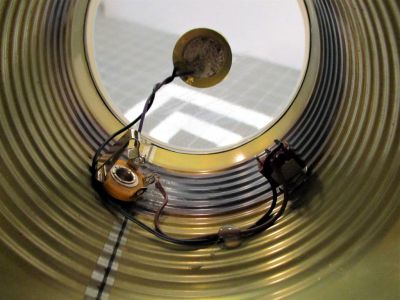If there’s any psychological good to be gleaned from quarantine, it’s that people are using the time to finish old projects while starting plenty of new ones. If you’re running out of ideas, or just want to feel better by doing some in-house recycling, dump out that bin and make a simple microphone.
 All you need is some PETE #1 plastic, a piezo disk, and the right kind of tin can. The plastic gets heat-fused to the rolled edge of the can, and since it gets stretched and shrunk in the process, it forms a tight membrane that doubles as a percussion instrument.
All you need is some PETE #1 plastic, a piezo disk, and the right kind of tin can. The plastic gets heat-fused to the rolled edge of the can, and since it gets stretched and shrunk in the process, it forms a tight membrane that doubles as a percussion instrument.
You do your shouting into the other end, and your sound waves vibrate the membrane. The piezo picks up the vibrations and sends them to a 1/4″ jack so you can plug it into an amp.
Even if you are somehow sidestepping the blues, you can always use this to yell at people who threaten to get too close to you. This fun project is about as open as it gets, but we’re sure that you can think of ways around using a piezo disk. Let us know in the comments after you check out [Ham-made]’s music video.
We like [Ham-made]’s method for cutting down the juice jug without cutting into yourself. Just clamp a razor blade into your vise and move jug against it. Reminds us of another way to easily reuse plastic soda bottles by making them into rope.















I have loads of electret microphones, taken out of tape recorders, cordless phones, I can’t remember what else.
But do you get decent sound quality out of them? I’m not sure if I’m just failing elsewhere, but it seems the random cheap tiny electrets have a pretty crappy sound quality, much worse than this seems to have.
You can. It’s where attention to detail in mounting and pre-amp pays off. Then also if you use a noisy power source instead of a plank flat 1V to them, you’ll get hiss and distortion off that too.
Through some complete accident, the first one I ever made as a kid was one that I found hard to equal on subsequent attempts until understanding occurred. It was just stuffed in a rubber grommet in the end of a PVC tube, with a headphone foam pad stretched over it, AA cell powering it, and reclaimed coax from an RCA cord that turned out to be quite decent. The amp was a board out of a 60s tabletop radio.
Actually, most small cheap electrets sound amazing. It’s almost hard to find a bad omni electret, which are the most common. What separates the good from the average are: noise, max level accepted, smoothness of response.
Random cheap tiny electrets are off the shelf pretty good.
I wouldn’t think much of a piezo disk, and arandom tin can can’t necessarily offer good sound.
Cheap electrets do have pretty wide bandwidth, though I don’t know how flat. If you need to put it into a case, that will affect sound, but the same applies to this project.
Fron the title I was expecting a razor blade and carbon rod (from batteries) on a cigar box. Taking a piezo disk isn’t far from an electret capsule, and if you have one, you might more likely have the other. You can also take a small speaker out of a transistor radio and use it as a microphone, if you add a suitable preamp.
Fifty years ago there were cheap crystal microphones, and cheap dynamic microphones, or steal a carbon microphone out of a telephone. But for a lotof purposes I’d choose a cheap elcectret capsule, cheaper, smaller and generally better than cheap microphones fifty years ago.
As far as hi fi electret condenser capsules go, look into the Primo EM272 capsules. They are a bit more than the easier to get Panasonic capsules, at a bit over $10 a pop after shipping and a minimum order of 10, but they have very nice specs. Most of the little electret condenser capsules do better with a bias voltage closer to the high end of their rating.
I can not comment on this mic as I have not touched it, but I can say that I have not seen a crystal mic since I was a kid. Inexpensive and better sounding dynamic mic’s seemed to have pushed them out of the market, and inexpensive and better sounding electret condenser mics seemed to have pushed lot of the crappy dynamics out of the market.
I have a bunch of stuff on half track tape that I recorded with some home built mic’s back in the 70’s. I no longer have the half track machine, and it was a mastering machine so it had 15 and 7.5 ips and not the more normal 7.5 and 3.75 ips. Last year someone gave me a quarter inch 4 track that needs some love. At some point in time I wanna see if I can get the audio off with either 2 or 4 of the tracks (have to see what sounds better – I can think of arguments for each case) and into my computer, and than bring it back to normal speed. I am really looking forward to this when I have time. I had a gas with my old film negatives when I got a slide scanner. This is like the audio equivalent.
I had a couple of NOS crystal mics kicking around in my random component box for years, never found anything to do with them. The kind of circuits that wanted them were usually all vacuum tubes and matching transformers.
Here is something related…
https://www.youtube.com/watch?v=ZlVI7YJGHq0
Don’t forget that soldering a piezo element can destroy it: overheating will de-pole the piezo material, and that temperature is less than the melting point of solder. Use a spring clip, conductive adhesive, or low temperature solder, a heatsink and quick touch.
Good to mention. I think I had all that somewhere, just filed under the tag “Piezo elements are a b!+ch, don’t mess with unmounted ones.” from abortive attempts to do so in the dim mists of time.
An alternative transducer, those beepers on modem cards and motherboards. Pry the cap of plastic off and an iron disc and circular pole electromagnet will be had for hacking a mic or transducer for musical instrument experiments.
That reminds me of El Silbo.
A sound powered transmitter.
http://soldersmoke.blogspot.com/search?q=El+silbo
“http://soldersmoke.blogspot.com/search?q=El+silbo”
Neat, reminds me of this design with a speaker: https://www.youtube.com/watch?v=mekmsgjSqR4
This is the sort of article that says: “How to build a microphone: Step 1, acquire a microphone.” This reader is surprised there was no Arduino involved.
Neat, reminded me of using an emergency blanket with a magnet and a coil and I finally found an online example, though not the example I was thinking of online I read about years back: http://theradioboard.com/rb/viewtopic.php?f=8&t=4609
Great to see the home brew microphone articles (there’s more than the E-field and B/H-field or waveforms): https://hackaday.com/2020/04/18/wood-and-carbon-rods-used-for-this-handsome-and-effective-microphone/
I’m sort of recently learning about MEMS that can detect up to 1MHz reads like:
http://dewdetectionprojects.blogspot.com/2020/01/ultrasonic-projects-and-others.html?showComment=1583547982898#c3079034608238353640